The great debate over whether or not to idle your diesel engine after a long haul rages on in numerous RV forums and Facebook groups. I’ve heard long time long haul truckers tell you don’t bother, diesel mechanics say it’s a must, and many RVers with opinions of their own. And then there are those who will insist it is just rude to leave your truck running when you arrive at a campground.
I’m here to settle that debate right now for anyone towing a fifth wheel or trailer with a diesel truck, and explain why…

Do you let your diesel engine idle when you stop?
Short Answer: Yes.
Why should you idle your diesel truck?
To maintain top performance and prevent costly repairs to your diesel engine, you should always let your truck idle for a few minutes after any long haul. I know, I’m speaking from personal experience.
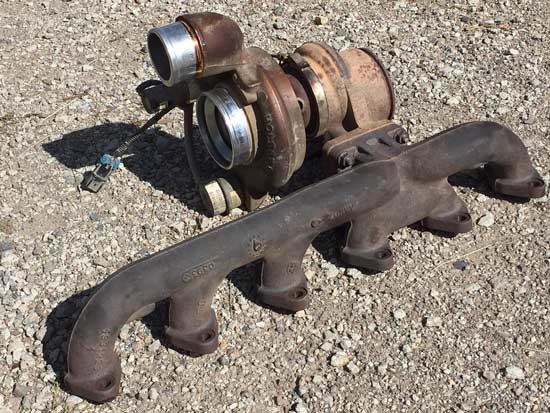
We first had our Dodge Ram Cummins diesel exhaust manifold worked on a few years ago after noticing a high pitched whine coming from under the hood when climbing steep hills. The noise slowly became more noticeable and more frequent over the next few weeks, when we started to notice a drop in power and acceleration. The mechanic pointed out the exhaust leak, indicated by black streaks escaping a port on the manifold.
That same mechanic replaced the exhaust manifold gasket. That was the first mistake. He also later described how difficult it was to get the manifold back on. That was the second sign we should have found a better mechanic.

What happened? After 6+ years of traveling full-time and neglecting to regularly let the engine cool down after long trips, the exhaust manifold had warped. At the time, we had no idea about such things. We continued full-time RVing as usual.
A couple years later, another mechanic pointed out an exhaust leak and blamed it on the first mechanic’s shoddy work. Another manifold repair later we were on our way with another mechanic bitching about the hard time he had getting the manifold back on. Well, duh. The thing had warped! I can say that now, knowing what I now know.

How to properly repair exhaust leaks?
Short Answer: Replace the manifold.
Both of the previously mentioned mechanics were hacks. They either took the cheap way out, or they didn’t know what they were doing. At least one of them literally hacked up the job by drilling out the manifold flanges to get the bolts to fit.
Before hitting the road last year, I noticed the tell-tale sign of yet another exhaust leak. I was determined to get the job done right, so I hoped we would make it back to our Vickers Ranch workamping job before noticing any serious symptoms. I’m glad we did, because that is where I consulted with my friend and certified diesel guru Dan the Man, and had him to the job right, for good!

How to prevent exhaust manifold leaks?
Short Answer #1: Let your engine cool down.
Dan explained how you must let the engine idle a while to cool down after any long haul to prevent the manifold from cooling too fast. The exhaust manifold gets hot, really hot on long trips, especially those over steep mountain passes. Stopping at the top of those passes and shutting the engine right off to enjoy the view is gonna get you in trouble. In short, the quick cooling will end up warping the manifold.

Short Answer #2: Install the best exhaust manifold.
Dan also explained the benefits of installing a two-piece manifold like the ATS Diesel Pulse Flow Exhaust Manifold. The Pulse Flow manifold is designed for performance and longevity, with some serious engineering behind it! The most noticeable feature of the ATS and other 2-piece manifolds is an expansion joint in the middle that allows the manifold to heat up and cool down more efficiently, without warping. You will notice it is also reinforced between the ports, making it stronger and less likely to warp.
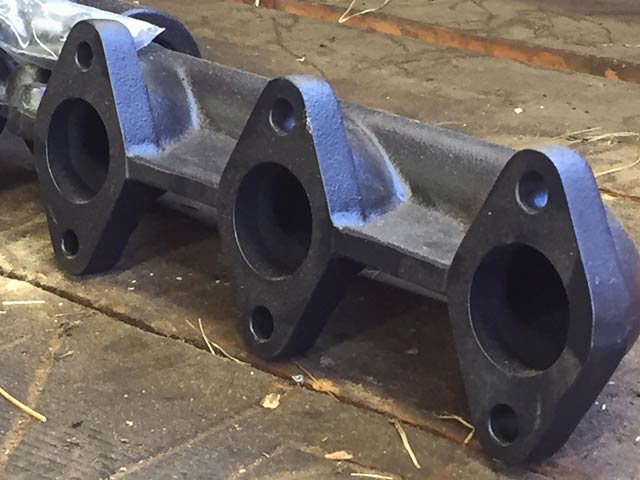
Yeah, the two part Pulse Flow Manifold is a bit more spendy, but it’s well worth the investment. It fit our 5.9L Cummins Diesel perfectly and has a stock Turbo connection—but we’ll get to that in a minute. After all, that ATS Diesel stands for Aurora Turbo Systems.
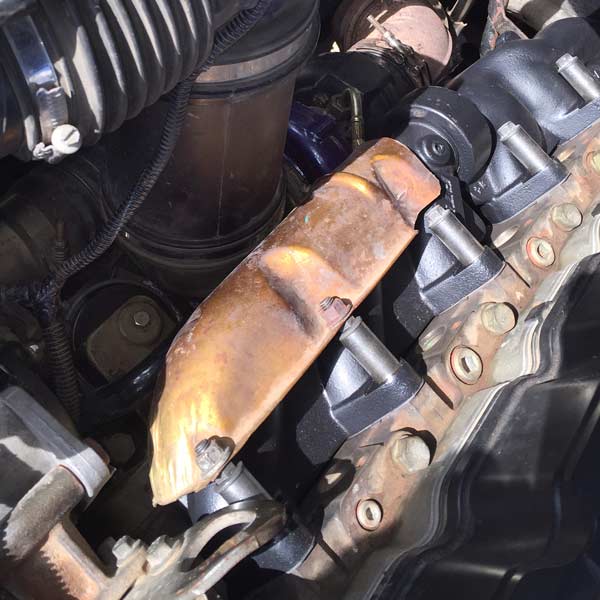
How long to idle diesel engines?
Having a top-of-the-line two-piece exhaust manifold does not exempt you from letting your engine cool down before shutting off the engine. In fact, you should pay even more attention to protect that investment in your tow vehicle. Dan explained that three to five minutes is usually sufficient for cooling down a diesel engine. He also said it isn’t necessary when just running about town without the trailer. But after long hauls you may want to idle the engine for up to seven minutes to allow the manifold to cool down.
That’s why the next toy on my wishlist is an Exhaust Temperature Gauge to provide peace of mind, knowing when it is OK to shut off the truck.
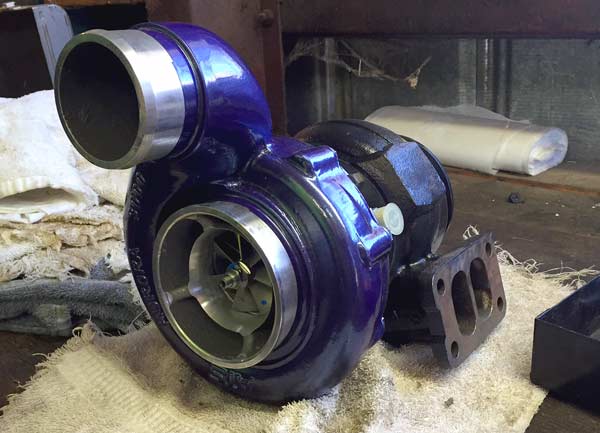
About that Turbo…
A good quality mechanic like Dan is going to do a thorough job and pay attention to detail when doing a job like this. If you end up replacing your exhaust manifold, and if your mechanic doesn’t mention the turbo, make sure you do. Or find another mechanic.
The turbo has to come off when replacing the exhaust manifold, so it should be inspected at the same time. On the Cummins Diesel engine the turbocharger has a tendency to go out at about 150,000 miles. Well, our odometer is about to hit 160,000. After removing our manifold, Dan identified the tiniest little crack in the turbo housing. He also had me spin the fins and feel the slightest resistance in one spot. It only made sense to replace the turbo at the same time. The alternative? Have the turbo explode within another few thousand miles. When that happens, all those tiny metal pieces get sucked into the engine, resulting in a true world of hurt.
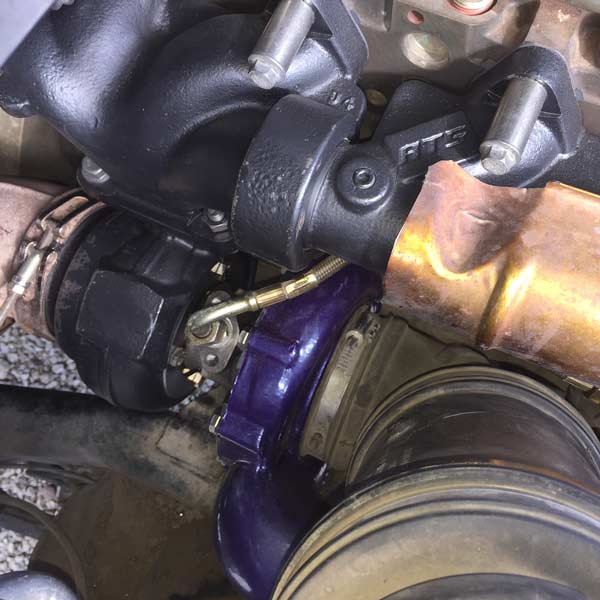
We bit the bullet, and took Dan’s advice to make another smart investment in our tow vehicle. We purchased a high quality aftermarket ATS Diesel Turbocharger System. Dan provided all sorts of technical reasoning about advanced engineering and airflow. I just kept seeing exploded turbo parts getting sucked into the engine in my mind.
Not only does the ATS Turbo look Bad Ass, it sounds cool and provides some serious pickup. On a test drive with Dan, he described how I should notice an improvement in performance. I proved him right as I gunned it up Slumgullion Pass. Only after driving our “new truck” for the past few weeks, did I realize how much power the engine had lost since first hitting the road 9+ years ago.

Pep, yeah we got that now. As we left the ranch, Dan said, “Don’t get a ticket!” Thankfully, we haven’t gotten that, though it would be pretty easy now. Another thing we do have now, is much better mileage. Since installing the new ATS Diesel Turbo and Pulse Flow Manifold, we’ve seen up to 17MPG when towing and as much as 22MPG without the trailer.
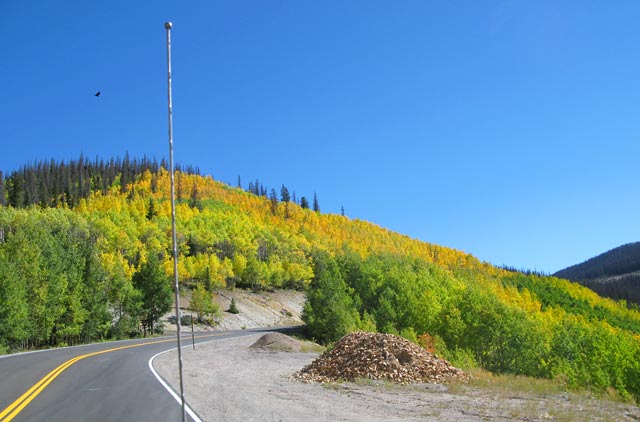
Any questions?
Do yourself a favor and let that diesel engine cool down a while the next time you pull into a campground. If you get any glaring looks, gun the engine and whistle at them with your new turbo!
Who is Dan and where can we find him?
As you probably know, Chrysler/Ram recommends the cooldown period in their owner’s manuals. But without the additional instrumentation, the average owner has no idea how long is long enough. Many simply shut them off without even thinking. In my opinion, because of this being something that can result in equipment damage costing thousands of dollars, Cummins / Ram should have made the shutdown timing automatic. You know, like, when the driver turns the key off, the engine keeps running and flashes a warning message on the EVIC display recommending allowing the engine to continue to run for cooldown, and “Do you really want to shut the engine off now? If yes, turn ignition back to “Run” and then “Off” again”
Good point, thanks!
The proper time to idle a diesel is with a egt gauge. I have had temps at 800 to 1000 degrees with no load . Why ? The exhaust was regenerating and that will require extra cool down time.
Roger that, an ETG is definitely on our wish list.
I lived next door to a diesel repair shop. There is no sound barrier wall between us. It is about 75 feet from my home. They have been letting trucks idle for over 2 hours. I want to know is it legally ok. Can a diesel truck idle for over 2 hours and do harm to me and my family?
Legal? You would need to contact your local authorities. As far as diesel exhaust being healthy at such a distance, I doubt you are in danger of any harm. But we are also neither doctors, nor environmental scientists.
One of the things I hope Dan mentioned to you when you’re running up a hill you get to the top of the hill and turn your engine off your turbo is still spinning but no oil pressure is going to the turbo so you’re actually running The turbo bearing dry (theres an aftermarket remedy for that call the pressure tank but you don’t need it
Also one other trick if you do need to idle for any reason more than a few minutes turn on your fast Idle that’s through your cruise control bring it up at least 600 RPMs more than what you got
By not doing that you create a low Idle situation called cylinder wash-down. (Not enough lubrication in the Pistons walls)
Yes, we did discuss the former. That’s why I don’t shut the engine off quickly if we stop at an overlook. Thanks for pointing out the latter. Great tip!
Great article. Nice pieces of information that would have been easy to ignore. Thank you.
Thanks for reading!
Nice write-up Jim, many thanks for sharing. I happen to have an Exhaust Gas Temp (EGT) with my Edge Juice / Attitude chip. I can attest that leaving the engine running after a long pull is easy to do and really not out of the ordinary for most RV’rs with the following considerations. The time it takes for me to pull into a campground, back in, position and then level sides with wheel blocks, provides more than enough time for the EGT to drop down to cool/idle temp. My point, leave the beast running during your setup and nobody will notice, keep a smile on your face and saying hi to folks will remove most RBF. (https://en.wikipedia.org/wiki/Resting_bitch_face)
Thanks for your interesting blog and hoping one day our paths cross.
Good point Rob! Thanks for sharing.
I like those mileage numbers. I’ve got a Ford F250 2005 diesel, and a few years ago went through the head gasket, turbo, etc etc replacement job they were famous for. Almost $10K Canadian dollars. This summer towing a 38′ 5th wheel, with truck and trailer together weighing in at about 26,750 lbs, I got from 8.6 in the mountains up to 13.6 mpg towing, and up to about 17 mpg just touring around truck only. You may think my numbers seem fairly good, but then I will tell that those were imperial gallons, not US gallons, which are smaller. 4.5 versus 3.8 liters. (Before somebody informs me that I’m overloading the truck, I already know that. Next season I’ll be towing with a 350 dually.)
Thanks for reading and commenting Dave! Happy Travels…